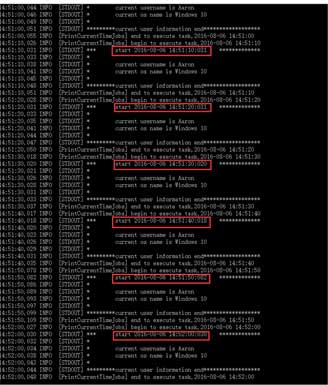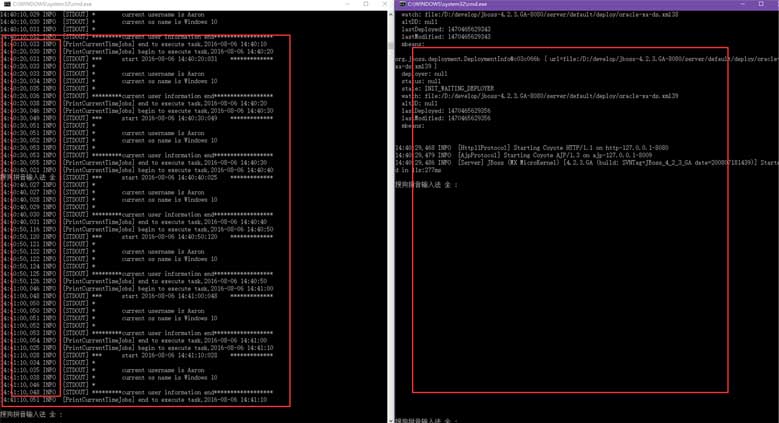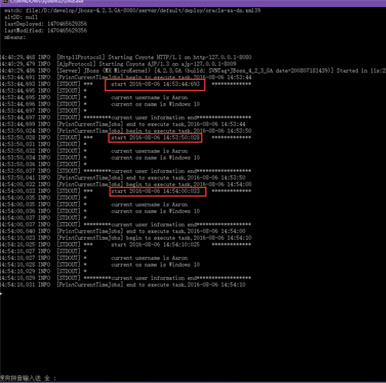基於spring+quartz的散布式定時義務框架完成。本站提示廣大學習愛好者:(基於spring+quartz的散布式定時義務框架完成)文章只能為提供參考,不一定能成為您想要的結果。以下是基於spring+quartz的散布式定時義務框架完成正文
問題背景
我公司是一個疾速開展的創業公司,目前有200人,次要業務是旅游和酒店相關的,使用迭代更新周期比擬快,因而,開發人員破費了更多的時間去更=跟上迭代的步伐,而缺乏了對整個零碎的把控
沒有集群之前,公司定時義務的完成方式
在初期使用的訪問量並不是那麼大,一台服務器完全滿足運用,使用中有很多定時義務需求執行
有了集群之後,公司定時義務完成的方式
隨著用戶的添加,訪問量也就隨之添加,一台服務器滿足不了高並發的要求,因而公司把使用給部署到集群中,前端經過nginx代理(使用服務器ip能夠是用防火牆停止了隔離,防止了直接運用ip+端口+使用名訪問的方式)。
在集群環境中,異樣的定時義務,在集群中的每台機器都會執行,這樣定時義務就會反復執行,不但會添加服務器的擔負,還會由於定時義務反復執行形成額定的不可預期的錯誤,因而公司的處理方案是:依據集群的數量,來把定時義務中的義務均勻分到集群中的每台機器上(這裡的均勻分是指以前一個定時義務原本是在一台機器上運轉,先在人為的把這個義務分紅幾局部,讓一切的機器都去執行這團體去)
目前集群中定時義務完成方式的缺陷
目前公司在集群中處置定時義務的方式不是正真的散布式處置方式,而是一種偽散布式(公司外部俗稱土辦法),這種方式存在一個分明的缺陷就是當集群中機器宕機,那麼整個定時義務就會掛掉或許不能一次性跑完,會對業務發生嚴重的影響
針對缺陷的處理方案(本文的重點之處)
應用spring+quartz構建一套真正的散布式定時義務零碎,經過查閱相關材料得知:quartz框架是原生就支持散布式定時義務的
開發IDE:Intellij IDEA
JDK版本:1.8
Spring版本:4.2.6
Quartz版本:2.2.1
Spring與Quartz集成配置
<?xml version="1.0" encoding="UTF-8"?>
<beans xmlns="http://www.springframework.org/schema/beans"
xmlns:xsi="http://www.w3.org/2001/XMLSchema-instance" xmlns:context="http://www.springframework.org/schema/context"
xsi:schemaLocation="http://www.springframework.org/schema/beans
http://www.springframework.org/schema/beans/spring-beans-4.0.xsd http://www.springframework.org/schema/context http://www.springframework.org/schema/context/spring-context.xsd">
<context:component-scan base-package="com.aaron.clusterquartz.job"/>
<bean name="dataSource" class="org.springframework.jndi.JndiObjectFactoryBean">
<!-- tomcat -->
<!--<property name="jndiName" value="java:comp/env/jndi/mysql/quartz"/>-->
<!-- jboss -->
<property name="jndiName" value="jdbc/quartz"/>
</bean>
<!-- 散布式事務配置 start -->
<!-- 配置線程池-->
<bean name="executor" class="org.springframework.scheduling.concurrent.ThreadPoolTaskExecutor">
<property name="corePoolSize" value="15"/>
<property name="maxPoolSize" value="25"/>
<property name="queueCapacity" value="100"/>
</bean>
<bean name="transactionManager" class="org.springframework.jdbc.datasource.DataSourceTransactionManager">
<property name="dataSource" ref="dataSource"/>
</bean>
<!-- 配置調度義務-->
<bean name="quartzScheduler" class="org.springframework.scheduling.quartz.SchedulerFactoryBean">
<property name="configLocation" value="classpath:quartz.properties"/>
<property name="dataSource" ref="dataSource"/>
<property name="transactionManager" ref="transactionManager"/>
<!-- 義務獨一的稱號,將會耐久化到數據庫-->
<property name="schedulerName" value="baseScheduler"/>
<!-- 每台集群機器部署使用的時分會更新觸發器-->
<property name="overwriteExistingJobs" value="true"/>
<property name="applicationContextSchedulerContextKey" value="appli"/>
<property name="jobFactory">
<bean class="com.aaron.clusterquartz.autowired.AutowiringSpringBeanJobFactory"/>
</property>
<property name="triggers">
<list>
<ref bean="printCurrentTimeScheduler"/>
</list>
</property>
<property name="jobDetails">
<list>
<ref bean="printCurrentTimeJobs"/>
</list>
</property>
<property name="taskExecutor" ref="executor"/>
</bean>
<!-- 配置Job概況 -->
<bean name="printCurrentTimeJobs" class="org.springframework.scheduling.quartz.JobDetailFactoryBean">
<property name="jobClass" value="com.aaron.clusterquartz.job.PrintCurrentTimeJobs"/>
<!--由於我運用了spring的注解,所以這裡可以不必配置scheduler的屬性-->
<!--<property name="jobDataAsMap">
<map>
<entry key="clusterQuartz" value="com.aaron.framework.clusterquartz.job.ClusterQuartz"/>
</map>
</property>-->
<property name="durability" value="true"/>
<property name="requestsRecovery" value="false"/>
</bean>
<!-- 配置觸發時間 -->
<bean name="printCurrentTimeScheduler" class="com.aaron.clusterquartz.cron.PersistableCronTriggerFactoryBean">
<property name="jobDetail" ref="printCurrentTimeJobs"/>
<property name="cronExpression">
<value>0/10 * * * * ?</value>
</property>
<property name="timeZone">
<value>GMT+8:00</value>
</property>
</bean>
<!-- 散布式事務配置 end -->
</beans>
quartz屬性文件
#============================================================================ # Configure JobStore # Using Spring datasource in quartzJobsConfig.xml # Spring uses LocalDataSourceJobStore extension of JobStoreCMT #============================================================================ org.quartz.jobStore.useProperties=true org.quartz.jobStore.tablePrefix = QRTZ_ org.quartz.jobStore.isClustered = true org.quartz.jobStore.clusterCheckinInterval = 5000 org.quartz.jobStore.misfireThreshold = 60000 org.quartz.jobStore.txIsolationLevelReadCommitted = true # Change this to match your DB vendor org.quartz.jobStore.class = org.quartz.impl.jdbcjobstore.JobStoreTX org.quartz.jobStore.driverDelegateClass = org.quartz.impl.jdbcjobstore.StdJDBCDelegate #============================================================================ # Configure Main Scheduler Properties # Needed to manage cluster instances #============================================================================ org.quartz.scheduler.instanceId=AUTO org.quartz.scheduler.instanceName=MY_CLUSTERED_JOB_SCHEDULER org.quartz.scheduler.rmi.export = false org.quartz.scheduler.rmi.proxy = false #============================================================================ # Configure ThreadPool #============================================================================ org.quartz.threadPool.class = org.quartz.simpl.SimpleThreadPool org.quartz.threadPool.threadCount = 10 org.quartz.threadPool.threadPriority = 5 org.quartz.threadPool.threadsInheritContextClassLoaderOfInitializingThread = true
相關類闡明
AutowiringSpringBeanJobFactory類是為了可以在scheduler中運用spring注解,假如不運用注解,可以不適用該類,而直接運用
SpringBeanJobFactory
package com.aaron.clusterquartz.autowired;
import org.quartz.spi.TriggerFiredBundle;
import org.springframework.beans.BeansException;
import org.springframework.beans.factory.config.AutowireCapableBeanFactory;
import org.springframework.context.ApplicationContext;
import org.springframework.context.ApplicationContextAware;
import org.springframework.scheduling.quartz.SpringBeanJobFactory;
/**
* @author
* @description 使job類支持spring的自動注入
* @date 2016-05-27
*/
public class AutowiringSpringBeanJobFactory extends SpringBeanJobFactory implements ApplicationContextAware
{
private transient AutowireCapableBeanFactory beanFactory;
public void setApplicationContext(ApplicationContext applicationContext) throws BeansException
{
beanFactory = applicationContext.getAutowireCapableBeanFactory();
}
@Override
protected Object createJobInstance(TriggerFiredBundle bundle) throws Exception
{
Object job = super.createJobInstance(bundle);
beanFactory.autowireBean(job);
return job;
}
}
package com.aaron.clusterquartz.job;
import com.arron.util.DateUtils;
import org.apache.commons.logging.Log;
import org.apache.commons.logging.LogFactory;
import org.quartz.JobExecutionContext;
import org.quartz.JobExecutionException;
import org.springframework.beans.factory.annotation.Autowired;
import org.springframework.scheduling.quartz.QuartzJobBean;
import java.util.Date;
/**
* @author
* @description 一句話描繪該文件的用處
* @date 2016-05-23
*/
public class PrintCurrentTimeJobs extends QuartzJobBean
{
private static final Log LOG_RECORD = LogFactory.getLog(PrintCurrentTimeJobs.class);
//這裡就是由於有上文中的AutowiringSpringBeanJobFactory才可以運用@Autowired注解,否則只能在配置文件中設置這屬性的值
@Autowired
private ClusterQuartz clusterQuartz;
protected void executeInternal(JobExecutionContext jobExecutionContext) throws JobExecutionException
{
LOG_RECORD.info("begin to execute task," + DateUtils.dateToString(new Date()));
clusterQuartz.printUserInfo();
LOG_RECORD.info("end to execute task," + DateUtils.dateToString(new Date()));
}
}
測試後果:
由於只要一台電腦,一切我開了8080和8888兩個端口來測試的,下面的定時義務我設置了每10秒運轉一次。
當只我啟動8080端口時,可以看到控制台每隔10秒打印一條語句

兩個端口同時啟動的比照測試中可以看到,只要一個端口在跑定時義務

這個關了正在跑定時義務的端口後,之前的另一個沒有跑的端口開端接收,持續運轉定時義務

至此,我們可以清楚地看到,在散布式定時義務中(或許集群),同一時辰只會有一個定時義務運轉。
整個demo地址:http://xiazai.jb51.net/201701/yuanma/spring-cluster-quartz_jb51.rar
以上就是本文的全部內容,希望對大家的學習有所協助,也希望大家多多支持。